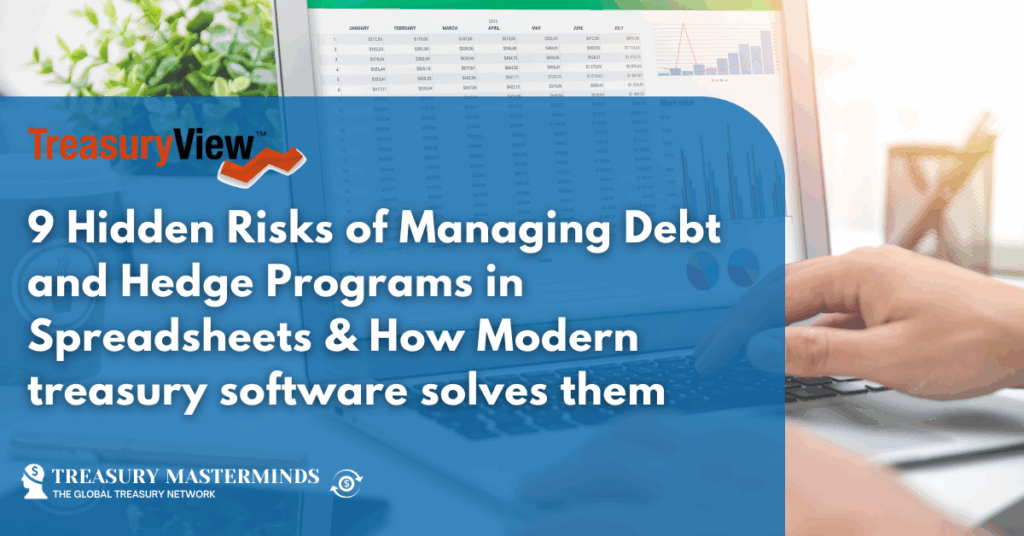
Maximizing Share of Wallet with Banking Partners: A Strategic Approach to Economic Efficiency
This article is written by our content partner, Nilus In today’s complex financial landscape, companies must do more than just maintain relationships with their banking partners—they need to strategically manage their Share of Wallet (SOW) to optimize economic outcomes. What is Share of Wallet in Banking? For companies, Share of Wallet refers to the portion of their total financial needs (loans, cash management, treasury services, etc.) that are fulfilled by a particular banking partner. Effectively managing this share can significantly impact a company’s financial health and growth potential. Why is SOW Management with Banks Crucial? How to Optimize SOW with Your Banking Partners? By strategically managing Share of Wallet with banking partners, companies can not only enhance their economic efficiency but also build stronger, more beneficial financial relationships that drive long-term success. Let’s not just manage our Treasury Operations—let’s optimize them by thoughtfully allocating our Share of Wallet. More from Nilus Join our Treasury Community Treasury Masterminds is a community of professionals working in treasury management or those interested in learning more about various topics related to treasury management, including cash management, foreign exchange management, and payments. To register and connect with Treasury professionals, click [HERE] or fill out the form below. Notice: JavaScript is required for this content.

Treasury Contrarian View: Everyone Is Replaceable — But Some Are More Replaceable Than Others!
We’ve all heard it: “No one is indispensable.” In corporate finance, especially in treasury, the phrase gets tossed around as both a comfort and a warning. But as the function evolves — becoming more strategic, more tech-enabled, more integral — the truth gets murkier. Are treasurers truly replaceable? The answer is yes. And no. Let’s unpack it. The Case For Replaceability Systems Don’t Need Heroes In a well-run treasury, excellence doesn’t hinge on individual memory. It’s embedded in systems, processes, and shared knowledge. If the function collapses when one person leaves, that’s not loyalty — it’s a design flaw. Knowledge Hoarding Isn’t Power — It’s Risk We sometimes confuse being the only person who knows how things work with being valuable. But monopolising institutional knowledge increases operational risk and discourages team growth. A truly resilient function thrives on transparency, not dependency. The Market Has Moved On The rise of fractional CFOs, interim treasurers, and on-demand expertise has shifted the power dynamic. Treasurers are no longer the sole guardians of cash and risk. Expertise is mobile. Insight is portable. If someone leaves, someone else can step in — often faster than we’d like to admit. Boards Expect Replaceable Structures Good governance demands succession planning, bench strength, and process documentation. The question isn’t if a key person might leave — it’s when. Replaceability isn’t a threat; it’s a requirement for continuity. The Case Against Replaceability You Can Replace a Role — Not a Mindset While a new hire can fill the org chart slot, replicating a treasurer’s judgment, risk appetite, or strategic instincts is another matter entirely. Some decisions — when to hold your nerve in a funding negotiation, how to pivot a hedging strategy mid-crisis — come from hard-won, situational intuition. That doesn’t live in a playbook. Trust Is Earned, Not Transferred Bankers, auditors, execs — they trust individuals, not job titles. When a treasurer with deep institutional and external relationships exits, it doesn’t just leave a gap in process — it leaves a vacuum in influence. That’s not something interim cover can immediately fill. Culture Is Carried by People The best treasurers don’t just execute — they shape the ethos of their teams. They model curiosity, rigour, pragmatism, and calm under fire. That cultural imprint is hard to replicate. You can replace a function; it’s harder to replace a standard. Leadership Isn’t Modular You can outsource processes. You can document controls. But you can’t modularise leadership. The ability to lead through ambiguity, drive transformation, and push finance into new territory isn’t mass-produced. It’s grown over time — and it sticks with the person who grew it. The Paradox: Replaceability as a Sign of Strength Here’s the irony: the best treasurers actively make themselves operationally replaceable. They invest in automation, delegate meaningfully, and document the hell out of their workflows. But that’s precisely why they’re so valuable. They’ve built something bigger than themselves. Being “replaceable” in day-to-day execution isn’t a weakness — it’s a strength. But being irreplaceable in strategic influence, judgment, and trust? That’s leadership. And the two can — and should — coexist. So What Should Treasury Leaders Do? Being replaceable doesn’t mean being irrelevant. It means you’ve done the hard work of building a function that will outlast you — and earned the credibility that means people hope you’ll stay anyway. What Do You Think? Is treasury truly plug-and-play — or are we undervaluing the irreplaceable qualities great leaders bring? We’re featuring views from across the profession. If you’ve built a treasury team that balances system resilience with human leadership, we’d love to hear your story. COMMENTS Lee-Ann Perkins, Treasury Masterminds Board Member, comments: Every worker is replaceable – some just take longer and are more expensive to replace. In theory, any treasurer is replaceable; in practice, it’s an uncomfortable truth that those who translate strategy into fit-for-purpose structures and cultivate deep stakeholder trust are anything but interchangeable. For boards and CFOs, the lesson is clear: if you’re lucky enough to have a strategic treasurer, invest in retention, because replacing that caliber of leadership can be costly and time-consuming. Elite treasurers align every funding, risk, and capital-allocation decision with the company’s evolving strategy, often pivoting before the rest of the organization senses the need. They redesign bank panels, cash-pooling rules, KPIs, and talent pipelines so that treasury infrastructure keeps pace with acquisitions, technology changes, or any other strategic shift. Seasoned treasurers build crisis-tested rapport with banks, rating agencies, and boards, securing tighter spreads, faster approvals, and looser covenants. When they leave, that goodwill departs with them, raising the true cost of capital. Even with AI automating reconciliations and dashboards, only a treasurer who can select, integrate, and govern those tools ensures they reinforce, not derail, strategic goals. Patrick Kunz, Treasury Masterminds Founder/Board Member, comments: Can you imagine doing the same job for 40 years?I can’t. And if you can, you might be at risk of becoming obsolete. Not just because it sounds incredibly boring (in my humble opinion), but because there’s zero challenge in doing the same tasks over and over again—especially in treasury, where things evolve fast. My longest tenure? Four years. That was my first job. The second? One year. Then I became a freelancer and never looked back. One of the best things I can offer my clients isn’t just experience or knowledge—it’s that I aim to make myself obsolete.Why?Because if I’m no longer needed, it means we’ve really improved their treasury setup.It’s leaner. Smarter. Automated. Scalable. And let’s be clear: making yourself (or a permanent team member) “obsolete” doesn’t mean pushing someone out.It means creating space—space for new projects, new ideas, new roles.Most teams are so caught up in day-to-day operations, they never get time to step back and innovate. But innovation needs time and mental bandwidth. The best treasurers I know?They reinvent. They try new things.They don’t cling to the same job title or process for decades—they evolve. That’s where growth happens. In 2025, with tech evolving faster than ever, the “same…

FASB Crypto Accounting Changes: A Jargon-free Guide
This article is written by Fortris The new FASB guidance on accounting for crypto assets such as Bitcoin has officially come into effect. Here’s a breakdown of the changes, and what they mean for businesses that hold (or are considering holding) Bitcoin on balance sheet. Background to the changes The Financial Standards Accounting Board (FASB) is an independent body recognized by the Securities and Exchange Commission (SEC) as the United States’ designated accounting standard setter. The FASB sets accounting standards for public and private companies and not-for-profit organizations that follow the US Generally Accepted Accounting Principles (GAAP). The FASB and crypto accounting Previously, the FASB had issued no specific guidelines on how cryptocurrencies such as Bitcoin should be recorded and measured on the balance sheet. But in December 2021, they announced a project to review how a certain subset of crypto assets are accounted for and reported on in financial disclosures such as quarterly and annual reports. The crypto assets covered by this review have six characteristics, which are explained in this video by the FASB. Cryptocurrencies such as Bitcoin are included, but other assets such as NFTs are not. In March 2023, the FASB released exposure documents for this proposed change, and invited public feedback. Finally, on 13 December 2023, the board issued their new guidelines in an Accounting Standards Update. What was the problem with the former system? Crypto assets such as Bitcoin were previously treated as indefinite-lived, intangible assets, along with other non-physical assets such as trademarks and patents. They were accounted for using a “cost-less-impairment” model. Impairment is a reduction in the value of a company’s asset. There were some exceptions for investment companies and broker-dealers, but otherwise, this meant the following: As discussed in a recent MicroStrategy World panel discussion with experts from Deloitte, this was a “one-way street”. The on-paper value of Bitcoin held by a company could be marked down, but not up, until it was sold – even if the price of Bitcoin rose in the interim. As the FASB noted in its media advisory of March 2023, this approach to accounting did not give clarity to potential investors. This is because the balance sheet value of a company’s Bitcoin holdings was unlikely to reflect its current market value, making it hard to assess the company’s financial health. It could also be time-consuming and therefore expensive for companies to track the lowest identifiable price for a crypto asset within any given reporting period, including within the day. What has changed under the new rules? The most headline-grabbing change in the FASB’s Accounting Standards Update (ASU) is the move away from the cost-less-impairment model. A move to fair value accounting for crypto As Deloitte expert Amy Park has explained, it is important to note that the FASB is not changing the categorization of crypto such as Bitcoin, which will still be considered as an intangible asset for GAAP purposes rather than a currency or other financial asset. However, they have changed the way that it is subsequently measured. Under the ASU, assets within the scope of the project are now measured at fair value instead of cost-less-impairment. In other words, financial reports should reflect the current market value of any Bitcoin rather than its historical low during the reporting period. Current market value is defined as the exit price (the price to sell that asset) in the principal market. What does this mean in practice? A key issue is how to define “principal market” in this context. The FASB voted not to provide specific guidance on this, and instead refers to existing guidance in ASC 820 on Fair Value Measurement. Those guidelines are written for a general rather than crypto-specific context. In effect, it is up to individual companies and their financial advisors how to identify the principal market. In a crypto context, there are some additional factors related to fair value measurements to consider. These include: Tax implications Recording the fair value of a company’s Bitcoin holdings in the profit and loss statement would fulfill accounting and audit requirements. But what about tax? As noted by Deloitte expert Rob Massey in a MicroStrategy World Tax and Accounting Panel, the rules on reporting for GAAP purposes do not always align with tax requirements. In the US, the IRS regards crypto assets such a Bitcoin as property. For most taxpayers, a capital gain or loss for tax purposes isn’t recorded until such time as Bitcoin is used or disposed of. This can result in a timing difference between GAAP and tax, which would generate a deferred tax asset or liability. Any deferred tax assets should then be evaluated for the need for a valuation allowance. The complexities of this are beyond the scope of this article, but it’s important to note that accurate recording and tracking of the cost basis of any amount of Bitcoin a company uses or holds is the key to fulfilling both accounting and tax requirements. Tracking the cost basis The more granular this information is, the more control the company has over which tranches of Bitcoin to dispose of and when, for maximum tax efficiency. This was the case under the cost-less-impairment model and will continue to be the case under the fair value model. The FASB noted in its exposure documents that “The Board decided not to provide specific guidance on how an entity should determine the cost basis of its crypto assets.” There are various methods for determining cost basis such as FIFO (first in, first out) LIFO (last in, first out) and specific identification. Under the new standards, whichever method a company uses, it will need to disclose it in financial statements. Further, there are separate considerations relevant for tracking cost basis and implementing a proper method for tax purposes. What other changes are included? 1) How to treat acquisition costs The FASB board also deliberated how companies should treat the costs of acquiring crypto assets. Such costs include Bitcoin mining fees (the commission paid…

Investec Capital Solutions and ETR Digital Partner to Bridge UK Trade Finance Gap for SMEs
London, UK – [17 June, 2025] – ETR Digital, a leader in financial technology innovation, is pleased to be assisting ICS explore opportunities to tackle the growing trade finance gap in the UK and beyond. At a period in world trade where access to flexible and timely pools of liquidity is critical for business responsiveness and growth, ICS is keen to take a pioneering role in exploring forward thinking solutions that draw on the inherent security and universal acceptance of digital negotiable instruments (DNIs). DNIs seamlessly integrate with existing funding products, offering businesses greater flexibility and allowing corporate customers to manage their working capital needs with increased speed and adaptability. A key facet of this initiative for finance directors and treasury managers is the introduction of the iC4DTI’s Cash Conversion Cycle Calculator https://ic4dti.org/getting-started-ccc/, a powerful tool in gaining deeper insights into working capital needs. By simply entering basic financial data such as turnover and accounts payable, corporates can instantly receive a comprehensive report comparing their performance against industry benchmarks. Rob Harris, Head of Operations and Technology at ICS, commented:“Investec Capital Solutions is proud to be at the forefront of exploring digital solutions that make trade finance more accessible and flexible for businesses. Tools such as the iC4DTI Cash Conversion Cycle Calculator, can offer finance teams a practical and immediate way to unlock working capital improvements.” Dominic Broom, CEO of ETR Digital, added:“We’re thrilled to be assisting ICS, a business that shares our commitment to providing innovative solutions to SMEs. By harnessing the power of digital negotiable instruments and business oriented tools like the iC4DTI Cash Conversion Cycle Calculator, we’re enabling businesses to achieve the financial flexibility they need to scale and grow.” Collaboration between ICS and ETR Digital can be a catalyst for broader industry-wide adoption of modern working capital solutions that bridge the gap between the business needs and available pools of liquidity. With a focus on promoting digital negotiable instruments and providing data-driven insights, the two companies are set to make a significant impact on the way UK SMEs access working capital and drive business growth. About Investec Capital SolutionsAn award-winning working solutions provider helping ambitious privately owned companies with growth. ICS is part of a leading UK corporate and investment banking business – Investec Bank plc, rated A1 by Moody’s and A- by Fitch Ratings. Investec Bank plc is the main banking subsidiary of Investec plc, a FTSE 250 listed company. About ETR DigitalETR Digital is a leading fintech company committed to driving innovation in financial services. Specialising in cutting-edge digital solutions, ETR Digital provides businesses with the tools they need to enhance their financial operations, optimise working capital, and scale effectively in a competitive landscape. Also Read Join our Treasury Community Treasury Masterminds is a community of professionals working in treasury management or those interested in learning more about various topics related to treasury management, including cash management, foreign exchange management, and payments. To register and connect with Treasury professionals, click [HERE] or fill out the form below. Notice: JavaScript is required for this content.

Exploring Stablecoin Strategies: Implications for Corporate Treasurers
From Treasury Masterminds In a significant move towards digital payment innovation, retail giants such as Amazon and Walmart are actively considering the launch of their own stablecoins. These stablecoins aim to streamline transactions, reduce card interchange costs, and potentially revolutionize the retail payment landscape. However, this ambitious step is not without its challenges. Understanding Stablecoins Stablecoins are digital currencies pegged to a stable asset, often fiat currencies like the US dollar, to minimize price volatility. For retailers, leveraging stablecoins offers advantages such as faster transactions, lower fees, and increased financial efficiency. By circumventing traditional banking systems, stablecoins also promise greater control over payment processes. Regulatory and Industry Challenges Despite these benefits, the path to adopting stablecoins is fraught with regulatory complexities and industry pushback. Regulatory bodies worldwide are scrutinizing stablecoin projects to ensure compliance with financial laws and consumer protection standards. Moreover, industry stakeholders debate the need for robust regulatory frameworks to safeguard against potential risks, including money laundering and market stability. Impact on Corporate Treasury For corporate treasurers, the rise of stablecoins presents both opportunities and challenges. On one hand, integrating stablecoins into payment ecosystems could streamline cash management, reduce transaction costs, and enhance liquidity management. On the other hand, treasurers must navigate regulatory uncertainties, operational complexities, and potential market volatility associated with digital currencies. Looking Ahead: Discussion Points As retailers explore stablecoin strategies, corporate treasurers are urged to stay informed and proactive. Understanding the implications of stablecoin adoption is crucial for shaping strategic decisions in treasury management. The dialogue around stablecoins prompts treasurers to consider: Join the Conversation The exploration of stablecoin strategies by retail giants underscores a transformative shift in payment methodologies, with direct implications for corporate treasury operations. As retailers navigate the complexities of stablecoin adoption, corporate treasurers must stay informed, proactive, and agile in embracing innovative payment solutions while managing regulatory and operational challenges. What are your thoughts on stablecoin adoption in corporate treasury? Is it a good or bad thing? Let’s discuss how these developments could impact your treasury operations. Reach out to us today to explore the opportunities and challenges of stablecoins for your organization. Stay tuned for more insights as the landscape of digital payments and corporate treasury evolves. Also Read Join our Treasury Community Treasury Mastermind is a community of professionals working in treasury management or those interested in learning more about various topics related to treasury management, including cash management, foreign exchange management, and payments. To register and connect with Treasury professionals, click [HERE] or fill out the form below to get more information. Notice: JavaScript is required for this content.

Stable Currencies vs. the USD
This article is written by HedgeGo The past few weeks have seen very wide swings in international stock and bond markets. Long-term interest rates have risen across the board, not only in the US but also in Europe and Japan. In particular, interest rates have undergone a correction in recent days, which has been felt globally. Rising interest rates, as we have seen in recent weeks, are a sign of market dysfunction. Central banks have not – of course – intervened, but we can assume that it would not have taken much for them to do so openly. Stock and Bonds Markets Have Been Volatile. Currency Markets Have Been Resilient. The yen’s strength is not unusual in the face of capital market turbulence, as large Japanese investors are among the first to sell assets in such a risk-off environment in order to avoid risks to their own yen balance sheets. As a first step, this process has led to a rise in the yen of just over 10% this year, which has so far been in line with the euro, against which the yen has remained stable. The other Asian currencies showed stability against the USD, rather than weakness as would have been expected in a “perfect storm”. In the past, the baht and ringgit have shown weakness during equity market sell-offs. What is probably unique about the current situation is that decades of correlations are breaking down. This is indicative of a fundamental change in the system; the political tensions we are seeing today are merely an expression of the change that is already taking place. It is no secret that Asia has a growing, young and hardworking population that is enjoying prosperity and growing self-confidence based on these characteristics. Asians no longer see themselves as inferior to the West. They are seeking greater autonomy and self-determination, both internally and politically. Trump’s approach of imposing very high tariffs on all countries, including those in Asia, is probably just an attempt to slow down this development of independence and to integrate the much smaller economies into a network of relationships. In recent years, ASEAN has been trading more and more with each other and has also greatly expanded its trade relations with China, which now does more trade with Asian economies than with the US. ASEAN integration is not an attractive development for the US either. As can be seen from Trump’s comments on the EU, any form of agreement that reduces US influence is an attack on the US. This is not even geostrategically wrong, but the way the Trump administration is going about it – all-out bulldozer attack – will provoke more resistance than interest in Asia. To Protect Own Reputation It is almost amusing how the US is trying to paint a picture of China being forced to seek a deal with the US. China shrugged off the imposition of 20% tariffs without comment. The increase to 34% was a slap in the face that Xi Jinping had to take in full, but he did not want to lose face (with his cadres and the people). The escalation to 145% tit-for-tat tariffs confirms this. The US can wait a long time for China to beg for negotiations, which will not happen – it will be interesting to see how the US deals with this. The other Asian countries, facing tariffs of up to 50%, are likely to feel the same way as China. Given their strong trade links with China, it is unlikely that Vietnam or Malaysia will turn their backs on China in order to be on good terms with the US. Again, this is about maintaining their own reputations with their own people, who in many Asian countries have large – and powerful – Chinese minorities. Also Read Join our Treasury Community Treasury Masterminds is a community of professionals working in treasury management or those interested in learning more about various topics related to treasury management, including cash management, foreign exchange management, and payments. To register and connect with Treasury professionals, click [HERE] or fill out the form below to get more information. Notice: JavaScript is required for this content.

9 Hidden Risks of Managing Debt and Hedge Programs in Spreadsheets & How Modern treasury software solves them
This article is a contribution from our partner, TreasuryView Spreadsheets might seem like an easy solution for treasury management, but they create more risks than they solve. Manual processes, outdated data, and a lack of real-time visibility lead to costly mistakes. That’s why CFOs and treasury teams, also from SMBs, are switching to Treasury Management Software (TMS). Through conversations with finance teams who upgraded from spreadsheets, we identified the 9 biggest risks that held them back—and how switching to Treasury Management Software solved them. 1. Small Errors in Spreadsheets = Big Consequences A single misplaced decimal, a broken formula, or a copy-paste mistake can lead to millions in miscalculated exposure. These errors often go unnoticed until it’s too late to fix. ✅ With treasury software: Automated calculations remove human errors, ensuring reliable, accurate financial data. 2. Making Decisions with Outdated Financial Data Markets shift daily, but spreadsheets stay static. Without current interest rates, FX rates, and debt refinancing conditions, every decision is a shot in the dark. ✅ With treasury software: Up to date market data keeps your decisions informed and proactive—not reactive. 3. Wasting Hours on Manual Work… in 2025 Updating debt schedules, generating reports, and fixing formula errors costs your team hours every week. Manual processes drain time that could be spent on strategy. ✅ With treasury software: Automated reports, cash-flow forecasts, and exposure tracking free’s up hours every week, letting your team focus on higher-value tasks. 4. No Clear Risk Exposure Visibility Spreadsheets store numbers—they don’t analyze them when computer lid closed. Hidden risks go unnoticed until they turn into actual financial losses. ✅ With treasury software: Instant dashboards highlight risk exposures before market moves impact your bottom line. 5. Data Silos & Version Confusion Who’s working with the latest file? Are the numbers even accurate? Treasury teams spend too much time chasing updates, increasing the risk of misalignment and costly errors. ✅ With treasury software: Connected work ensures everyone works with the same, up-to-date data—no back-and-forth emails needed. No new spreadsheet versions needed. No data overwriting. 6. No Audit Trail & Compliance Risks Who changed the reference rate fixing in last month’s overview? No one knows. Spreadsheets don’t track changes, making audits a nightmare and leaving your company exposed to compliance risks. ✅ With treasury software: Every change is logged automatically, ensuring a clear audit trail for compliance. 7. Data Loss & Security Risks A laptop crash, accidental deletion, or an employee leaving—and critical financial data or knowledge is gone. Spreadsheets have no security controls, putting sensitive treasury data at constant risk. ✅ With treasury software: Secure cloud-based storage protects your financial data from loss or unauthorized access. 8. No Way to Test Hedging Scenarios Treasurers need to stress test financial positions taking rising interest rates, FX volatility, and liquidity risks into account—but spreadsheets make scenario planning incredibly slow and unreliable. ✅ With treasury software: Built-in scenario simulations let you plan for different scenarios, including doing nothing. More about hedging. 9. Spreadsheets do not Support the Growth More debt, more FX transactions, more risks. Spreadsheets don’t scale—as business complexity grows, so does the manual workload and the potential for costly mistakes. ✅ With treasury software: A cloud software that scales with your business, without adding complexity or extra manual work. Why smaller Treasury and Finance Teams Are Switching to Treasury Management Software ? Spreadsheets may be familiar, but they’re holding your treasury team back. Treasury Management Software (TMS) replaces error-prone manual work with: ✅ Live Market Data – Stay ahead of risk with real-time interest rates and FX movements. ✅ Time-Saving Automations – Cut manual processes and free up hours every week. ✅ Clear Risk Visibility – Spot exposures before they impact your P&L. ✅ Scalable & Future-Proof – Treasury management that grows with your business. ✅ Better Security & Control – Centralized, cloud-based access with full audit trails. Also Read Join our Treasury Community Treasury Mastermind is a community of professionals working in treasury management or those interested in learning more about various topics related to treasury management, including cash management, foreign exchange management, and payments. To register and connect with Treasury professionals, click [HERE] or fill out the form below to get more information. Notice: JavaScript is required for this content.

A comprehensive guide to different hedging programs.
This guide is from our content partner, Ebury To manage currency risk, companies need to develop hedging strategies to minimise the impact of currency fluctuations on their margins. There are mainly three commonly used hedging strategies that companies deploy: 1. Static hedging program It is usually associated with a conservative risk profile and a high protection level. Here, you purchase one or multiple forward contracts simultaneously to cover your entire exposure. Upon entering a new period, you purchase a new set of hedges to cover the following period. 2. Rolling hedging program Here, you hedge a fixed amount to a future date. In this program, you continuously extend hedges with new hedges at a later date for the same tenure, thus ensuring continuous coverage. This helps you maintain a constant hedge ratio, smoothen volatility and achieve more stable and predictable hedging outcomes. 3. Layered hedging program Hedges are applied in progressive layers, and you do not need to achieve a 100% accurate forecast. Each hedging period has a set hedge ratio. As your hedging period comes to an end, you top up the hedge to meet the predefined hedging ratio set out in the policy. Hedge ratios are usually greater for near dates when predictability is higher and lower for further dates. The longer the tenor of your strategy and the higher the frequency, the more ‘smoothing’ effect on volatility you create. A quick overview of different hedging program Good to know Having covered different hedging programs, your choice of the right strategy for your business is based on many factors – visibilityof future transactions, risk tolerance, exposure assessment, sensitivity analysis of exchange rates and many more. Also Read Join our Treasury Community Treasury Masterminds is a community of professionals working in treasury management or those interested in learning more about various topics related to treasury management, including cash management, foreign exchange management, and payments. To register and connect with Treasury professionals, click [HERE] or fill out the form below. Notice: JavaScript is required for this content.

Understanding the Differences Between Customer Due Diligence (CDD) and Know Your Customer (KYC)
This article is a contribution from one of our content partners, Avollone When I started my career years ago in the ethics and compliance sector, it wasn’t completely clear what the difference was between Customer Due Diligence (CDD) and Know Your Customer (KYC). To be honest, it’s still rather unclear and difficult today to understand how and why the two are not the same. Why? It’s because the terminology, when used in general (that is all situations from internally between colleagues, externally with counterparties and overall with LinkedIn posts from various organizations), many people often will say CDD and KYC interchangeably. But, in my opinion having worked with Anti-Money Laundering (AML) for over two decades, CDD and KYC do represent very distinct processes – each with unique purposes and scopes. And understanding their differences is key for effective implementation. A Bit of Background The term Customer Due Diligence (CDD) comes from FATF recommendations and is often the term used in regulation that refers back to FATF recommendations. On the other hand, Know Your Customer (KYC) is not used as a term in regulation. It is more of a sector standard term. Maybe that is also why so many use it in different ways. So, my comments are also based on what I think of KYC and how I’ve experienced the work associated with the term KYC. Starting with the Similarities Customer Due Diligence (CDD) and Know Your Customer (KYC) do share a common purpose: identifying, assessing and mitigating risks associated with business relationships or transactions. Both are essential parts of compliance frameworks, especially when it comes to preventing financial crimes – such as fraud, money laundering and the financing of terrorist groups. Differentiator: KYC – The Foundation of Customer Identification Where the two diverge is that KYC is a regulatory requirement that focuses on verifying the identity of customers before establishing or continuing a business relationship. Its primary goal is to ensure that financial institutions and businesses know who they are dealing with, and KYC processes typically involve collecting and verifying basic information – for example, identification documents, proof of address and information about the customer’s source of funds and wealth. KYC is the starting point for any compliance framework, providing a baseline understanding of the customer’s legitimacy, and as you’ll see below, KYC can actually be considered to be a subset of Customer Due Diligence. Differentiator: CDD – A Broader Risk Assessment CDD goes beyond the initial identification step of KYC – as CDD is a much deeper investigation into a customer, vendor or counterparty – to assess their risk profile with a wider range of related tasks and activities. CDD processes evaluate factors like financial history, business activities, beneficial ownership structures and connections to high-risk jurisdictions. Note that CDD is not limited to onboarding; it extends to ongoing monitoring, enhanced scrutiny for high-risk clients and investigations into potential red flags. The Relationship between KYC and CDD Simply put, KYC is a part of CDD. KYC provides the “who,” while DD examines the “why” and “how” of a business relationship. And together, they form a complete, robust framework for protecting businesses and maintaining regulatory compliance. At the end of the day, it would be less confusing if everyone aligned on the same terminology. But this may not change easily in everyday practice, so it’s important for everyone to clarify the usage of important terms when working together – not just for these two acronyms (CDD and KYC), but also with the many others within AML that are also used interchangeably – which I’ll be writing on further in the future (such as Know Your Business (KYB), Due Diligence (DD) and more!) Also Read Join our Treasury Community Treasury Masterminds is a community of professionals working in treasury management or those interested in learning more about various topics related to treasury management, including cash management, foreign exchange management, and payments. To register and connect with Treasury professionals, click [HERE] or fill out the form below. Notice: JavaScript is required for this content.